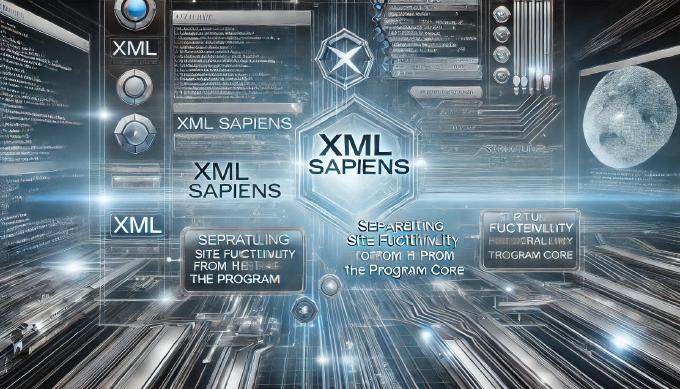XML Sapiens is a tool to divide site functionality and program core

Each minute the amount of content in the Web is surging up. This tendency is getting more and more intensive. As a result, tough competition makes web site-builders develop complicated interfaces to content. New generations of Content Management Systems (CMS) are replacing one another with impressive dynamics. Modern solutions require brand-new features, unavailable in the recent past. Tomorrow they' will need features, which are not available today. The question “How do I save my investment to web development?” is still open.
If to start analyzing CMS evolution you may notice that the bottleneck is fixed functionality tied to program core.?This is the same kind of limitation as with content and HTML being not separated before XML/XSL replaced HTML. XML/XSL replaced HTML and here was the way out. But what would solve problems related to site functionality inseparable of program core? May be it would be XML Sapiens?
Red Graphic Systems is presenting XML Sapiens, a specification for program interfaces of CMS-powered web sites. This specification outlines the concept with separated functionality and its presentation. It means that site interfaces are not attached to program core in systems complying with requirements of XML Sapiens. For example, to create a new interface you do not need to re-program you CMS, you only need to add a new interface description to XML Sapiens dictionary.
How does it work? In common way, while you request document URI, XML Sapiens environment variables are set. Depending on them the site engine requests the data and a presentation template from data depositary (for example, database). Both of them are delivered to XML Sapiens parser. It parses presentation template, analyzes objects of XML Sapiens and processes them according to the rules that are described in XML Sapiens Dictionary. For example, dynamic data containers are replaced with code, which was generated by algorithm based on model represented in this object description and environment arguments. Query containers in case of data delivery (displaying the page to a site visitor) are replaced with appropriate data they are pointing to. In case of site administration they are replaced with query forms, requesting this data.
Furthermore, XML Sapiens Specification provided here also describes the model of CMS, which is based on data arrays for information areas, including numerous sites and their language versions.
Hopefully, XML Sapiens helps develop CMS, which will be able to self-evolution and superstructure for the day after tomorrow
